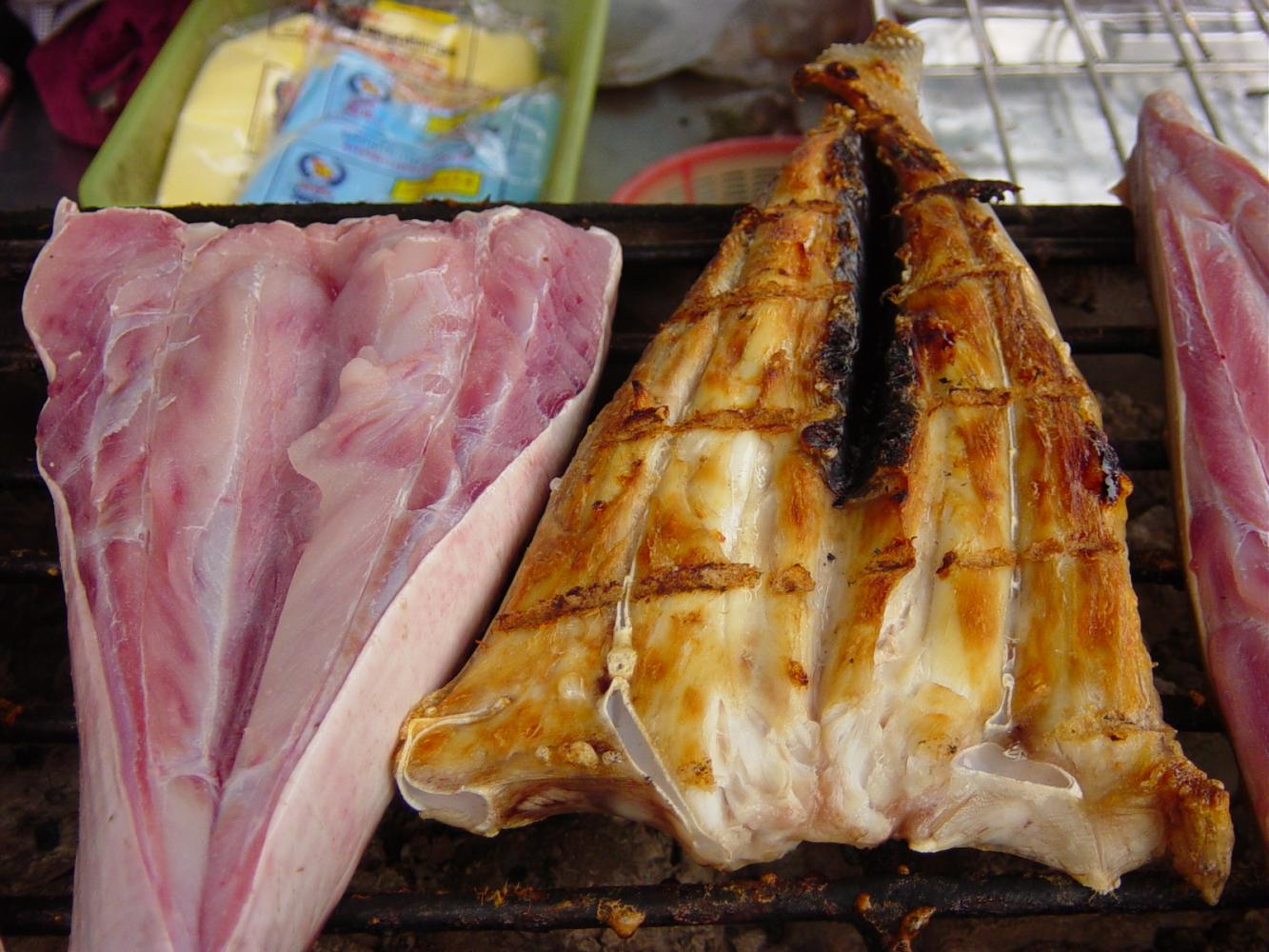Foods come and go all the time.
Some dishes disappear because fewer people know how to cook it, ingredients are too hard to find or enthusiasm simply fades away with time. Some dishes lose their appeal to the new generation while others change entirely with no trace of authenticity.
One of the genuine Thai dishes missing from modern menus is nuea khem tom krati (salted beef stewed in coconut cream). It is hard to find salted beef in the market these days. Nuea khem is prepared by rubbing fresh beef with salt and then sun-drying it. Since fresh beef is very expensive and its weight is lost substantially when dried, the makers have to add cost to offset the lost weight. Moreover, only a prime cut is good for making dry salted beef. Therefore it is more worthy to use such a premium meat for something else that generates more value.

Salted beef in a Muslim market.
Some households opt to grill a large piece of salted beef first before slicing it into small, thin strips, then it is cooked with coconut milk and a lot of sliced shallots. A little bit of coconut sugar is added to attain a balanced taste that combines sweetness from sugar, saltiness from the beef and the nuttiness of the coconut cream.
A similar form of dried beef is nuea foi khem pad wan (sweet and savoury shredded beef). The large piece of salted beef is shredded across the grain into small, thin strips and deep fried. It is then tossed in caramelised coconut sugar and left to dry. The sweet and savoury shredded beef is less common nowadays. It used to be paired with khao man som tam, served as a side dish of traditional Thai cuisine khao chae or Mon 'Songkran rice'. The dish is largely replaced with moo foi pad wan (sweet and savoury shredded pork).

Green curry with beef.
Another disappearing dish is green curry beef. Originally, green curry was made from beef only. The curry paste has to be specially prepared as it requires extra spices in addition to basic ingredients such as green bird's-eye chilli, lemongrass, galangal, kaffir skin, shallot, garlic and shrimp paste. The extras are coriander seeds, cumin, cardamom, nutmeg, star anise, cloves and ground sand ginger. The paste masks the meaty odour while the spices make the curry more aromatic. The green curry beef has gradually drifted from the table. These days people prefer curry with pork, chicken and clown featherback fish balls. Thus, the curry paste formula is simplified accordingly by omitting the spices.
The peculiarity of stingray curry is the fin, which contains a lot of soft and crunchy cartilage bones. Stingray has a strong fishy odour but cooks have a solution. The fins are cut into big chunks, grilled and then sliced into small pieces. Curry paste for making stingray curry contains typical ingredients plus some spices including coriander seeds, cumin seeds, cloves and cardamom. This dish disappeared from Thai menus a long time ago.

Stingray must be grilled before cooking it in a curry.
Also vanished is an eel curry with raw lady finger banana (kluai kai). First of all, the eel must be cleaned by using the abrasive khoi leaves to remove slime on the eel's skin. Once spotlessly clean, it is cut into pieces and cooked with gaeng ped curry paste along with spices and sliced raw kluai kai.
Santol curry with frog is perhaps one of the oldest Thai traditional dishes. The santol tree is usually tall with a huge trunk. It is versatile but somehow sunk into oblivion. Its fruit is sour but the meat is soft and fluffy. To make curry, the fruit is peeled, sliced and soaked in salt water to minimise the sour and astringent taste. Santol curry uses basic gaeng ped curry paste with some coriander seeds and cumin seeds. Frog was later replaced by pork as people feel the animals have little meat. Notably, either with frog or pork, santol curry is almost non-existent in present times.
Tod man goong foi (baby shrimp cakes) is made from tiny shrimps collected from fresh water habitats. Normally, people who live along canals harvest the shrimp and process them into shrimp paste. But the northeastern people prefer to make them into a hot and spicy yam (salad) by mixing the freshly caught tiny shrimps with a lot of chilli, lime juice, sliced shallots and fish sauce.
Tiny shrimps are prepared as tod man goong by deep-frying them in batter -- a mixture of rice flour, coconut cream and salt. Despite being very small in size, the shrimps have a pointed head that hampers eating. This may be the reason why it never became widely popular.

Santol fruits.
Another rare dish is fried clown featherback fin. After the flesh is removed, the leftover fin is dipped in flour and deep-fried. It is served with ajad sauce as a side dish. Deep fried food was customarily served with ajad sauce made from cucumber, shallots, red chilli, ground peanuts, vinegar, sugar and salt.
Many more dishes have disappeared from the cooking scene. Food connoisseurs may wish to see them return, but it is hard to say if that will ever happen.

